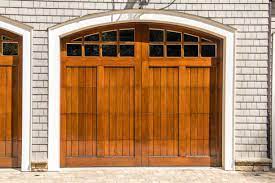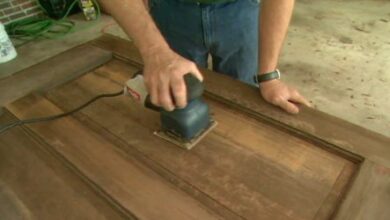A wood garage door brings warmth and classic style to your home. But wood, being a natural material, is susceptible to damage from weather, accidents, and everyday wear and tear.
Fortunately, many common issues with wood garage door panels can be tackled with some DIY know-how.
This article will walk you through the process of assessing the damage, gathering your supplies, and making effective repairs. We’ll also cover when it’s wise to call in the pros.
Assessing the Damage: Know Your Enemy
Before you grab your tools, take a close look at the damage. Understanding the type and severity of the problem will determine the best course of action.
- Minor Dents and Scratches: These are surface imperfections that affect the appearance but not the structural integrity of the panel. Think minor scrapes, small dents from basketballs, or shallow scratches from wayward branches.
- Cracks and Splits: These are more serious than surface imperfections and can weaken the panel over time. Cracks can be caused by impact, weather changes, or the natural expansion and contraction of the wood.
- Rot: Rot is a significant issue that compromises the wood’s strength and requires more extensive repair. It’s often caused by prolonged exposure to moisture. Look for soft, spongy areas, discoloration, and a crumbly texture.
- Warping: Warping occurs when wood absorbs moisture unevenly, causing it to bend or twist. This can affect the door’s operation and overall appearance.
- Panel Separation: The individual boards that make up the panel can sometimes separate due to glue failure or weather exposure.
Gathering Tools and Materials: Your Arsenal
Having the right tools and materials will make your repair project smoother and more efficient.
- Safety Gear: Safety first! Always wear safety glasses and gloves to protect yourself from splinters, dust, and chemicals.
- Putty Knife: Essential for applying and smoothing wood filler.
- Sandpaper: You’ll need various grits, from coarse to fine, for smoothing filled areas and preparing the surface for painting or staining.
- Wood Filler: Choose a high-quality exterior-grade wood filler that is paintable and weather-resistant.
- Wood Glue: A strong, waterproof wood glue is essential for repairing cracks and splits.
- Clamps: Clamps are crucial for holding glued pieces together while they dry.
- Paint Scraper: Useful for removing loose or peeling paint.
- Screwdriver: Needed for removing and reinstalling hardware.
- Drill: A drill with various bits can be helpful for pre-drilling holes for screws and other tasks.
- Paint or Stain: Select a paint or stain that closely matches the existing finish on your garage door.
Repairing Minor Dents and Scratches: A Quick Fix
- Clean the Area: Use a damp cloth or a mild cleaning solution to remove dirt and debris from the damaged area.
- Apply Wood Filler: Use a putty knife to apply wood filler to the dent or scratch, overfilling slightly.
- Smooth the Filler: Smooth the filler with the putty knife, feathering the edges to blend with the surrounding wood.
- Let it Dry: Allow the filler to dry completely according to the manufacturer’s instructions.
- Sand Smooth: Sand the dried filler with fine-grit sandpaper until it’s smooth and flush with the surrounding wood.
- Touch Up: Apply a matching paint or stain to the repaired area.
Repairing Cracks and Splits: A Bit More Involved
- Assess the Crack: Determine the depth and extent of the crack. For deep cracks, you may need to widen them slightly with a utility knife to allow for better glue penetration.
- Apply Wood Glue: Inject wood glue into the crack, ensuring it reaches the full depth.
- Clamp: Clamp the split wood together tightly, ensuring the surfaces are aligned.
- Remove Excess Glue: Wipe away any excess glue that squeezes out with a damp cloth.
- Let it Dry: Allow the glue to dry completely according to the manufacturer’s instructions.
- Reinforce and Finish: Apply wood filler to the crack, smooth it out, let it dry, and sand smooth. Then, touch up with paint or stain.
Dealing with Rot and Warping: Major Surgery
- Rot: Rotted wood must be replaced. This involves carefully removing the damaged section and cutting a new piece of wood to fit. Secure the replacement piece with wood glue and screws, then fill any gaps with wood filler, sand, and finish.
- Warping: Minor warping can sometimes be corrected by clamping the warped section and applying gentle pressure. For severe warping, panel replacement is often the best solution.
When to Call a Professional: Knowing Your Limits
While many repairs can be handled DIY, some situations require professional expertise.
- Extensive Damage: If the damage is widespread or affects multiple panels, it’s best to call a professional. They have the tools and expertise to efficiently handle large-scale repairs or replacements.
- Structural Issues: Any damage to the garage door frame or tracks requires professional attention. These components are crucial for the door’s safe and proper operation.
- Lack of Experience: If you’re uncomfortable working with tools or unsure about any step of the process, don’t hesitate to call a pro. Improper repairs can worsen the problem and even create safety hazards. Check out our garage door repair services page for more information:https://fnjsgarage.com/garage-door-repair-services/
- Spring Issues: Never attempt to repair or replace garage door springs yourself. Springs are under extreme tension and can cause serious injury if mishandled. Always leave spring repairs to qualified technicians.
Maintaining Your Wood Garage Door: Prevention is Key
Regular maintenance can prevent many problems and extend the life of your wood garage door.
- Cleaning: Clean your garage door regularly with a mild detergent and water to remove dirt, grime, and salt deposits.
- Inspection: Inspect your door periodically for any signs of damage, such as cracks, rot, or loose hardware. Addressing these issues early can prevent them from becoming more serious and costly.
- Sealing and Finishing: Apply a fresh coat of paint or stain every few years to protect the wood from the elements and maintain its appearance. A good sealant will help prevent moisture penetration and reduce the risk of rot and warping.
Conclusion
With the right approach, repairing wood garage door panels can be a satisfying DIY project. By following the steps outlined in this article, you can restore your door’s beauty and functionality. However, remember to prioritize safety and know your limits. For complex repairs or any concerns about your garage door’s operation, don’t hesitate to seek professional assistance.
Need expert help with your garage door? Call F&J’s 24 Hour Garage Door Service at 623-853-8487 for a free consultation and let our experienced technicians handle your garage door repair needs.





